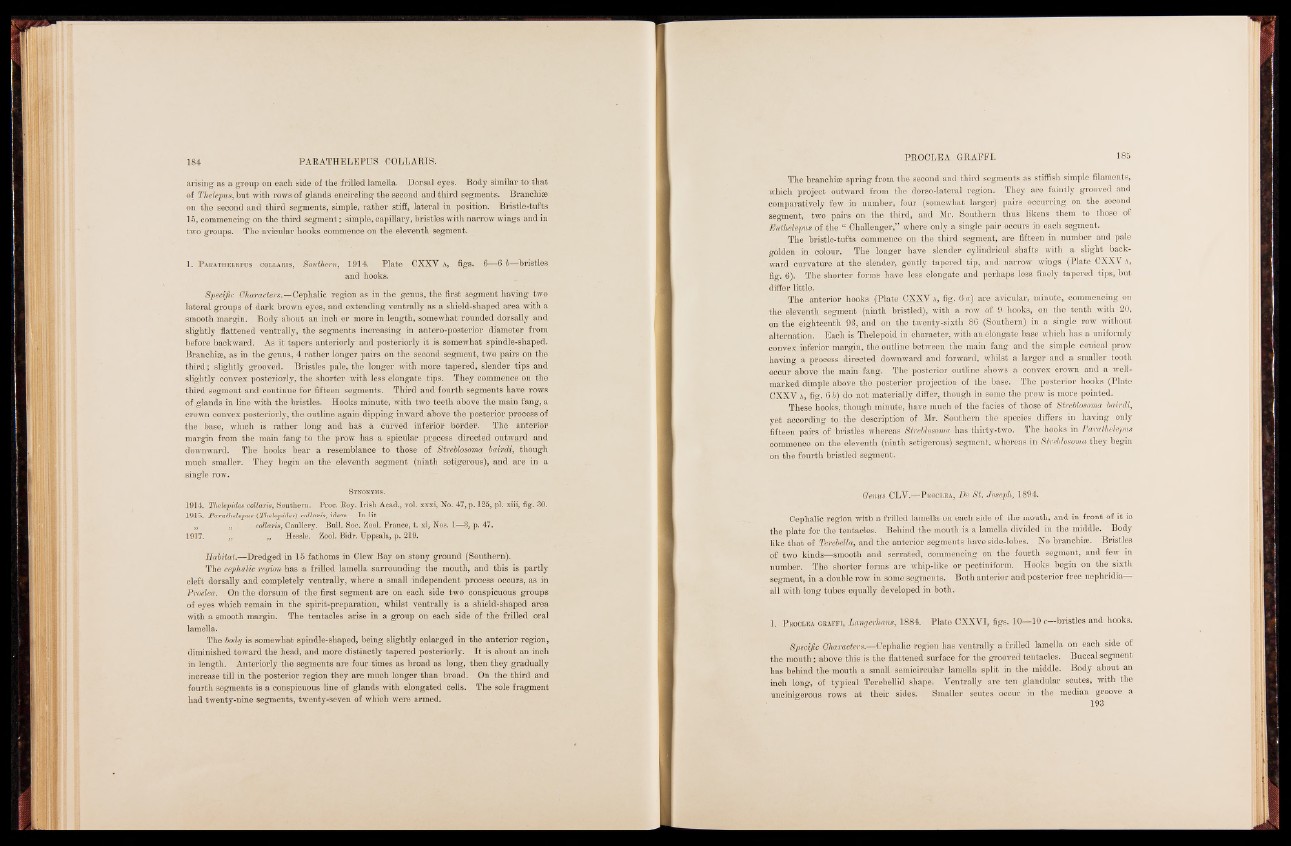
arising as a group on each side of the frilled lamella. Dorsal eyes. Body similar to that
of Thelepus, but with rows of glands encircling the second and third segments. Branchiae
on the second and third segments, simple, rather stiff, lateral in position. Bristle-tufts
15, commencing on the third segment; simple, capillary, bristles with narrow wings and in
two groups. The avicular hooks commence on the eleventh segment.
1. P arathelepus collaris, Southern, 1914. Plate CXXV a, figs. 6—6 b—bristles,
and hooks.
Specific Characters.—Cephalic region as in the genus, the first segment having two
lateral groups of dark brown eyes, and extending ventrally as a shield-shaped area with a
smooth margin. Body about an inch or more in length, somewhat rounded dorsally and
slightly flattened ventrally, the segments increasing in antero-posterior diameter from
before backward. As it tapers anteriorly and posteriorly it js somewhat spindle-shaped.
Branchiae, as in the genus, 4 rather longer pairs on the second segment, two pairs bn the
third; slightly grooved. Bristles pale, the longer with more tapered, slender tips and
slightly convex posteriorly, the shorter with less elongate tips. They commence on the
third segment and continue for fifteen segments. Third and fourth segments have rows
of glands in line with the bristles. Hooks minute, with two teeth above the main fang, a
crown convex posteriorly, the outline again dipping inward above the posterior process of
the base, which is rather long and has a curved inferior border. The anterior
margin from the main fang to the prow has a spicular process directed outward and
downward. The hooks bear a resemblance to those of Streblosoma bairdi, though
much smaller. They begin on the eleventh segment (ninth setigerous), and are in a
single row.
Synonyms.
1914. Thelepides collaris, Southern. Proc. Roy. Irish Acad., vol. xxxi, No. 47, p. 125, plrxiii, fig. 30.
1915. Parathelepus (Thelepides) collaris, idem. In lit.
. „, „ collaris, Caullery. Bull. Soc. Zool. Prance, t. xl, Nos. 1—3, p. 47.
1917. „ ,, Hessle. Zool. Bidr. Uppsala, p. 219.
Habitat.—Dredged in 15 fathoms in Clew Bay on stony ground (Southern).
The cephalic region has a frilled lamella surrounding the mouth, and this is partly
cleft dorsally and completely ventrally, where a small independent process occurs, as in
Proclea. On the dorsum of the first segment are on each side two conspicuous groups
of eyes which remain in the spirit-preparation, whilst ventrally is a shield-shaped area
with a smooth margin. The tentacles arise in a group on each side of the frilled oral
lamella.
The body is somewhat spindle-shaped, being slightly enlarged in the anterior region,
diminished toward the head, and more distinctly tapered posteriorly. It is about an inch
in length. Anteriorly the segments are four times as broad as long, then they gradually
increase till in the posterior region they are much longer than broad. On the third and
fourth segments is a conspicuous line of glands with elongated cells. The sole fragment
had twenty-nine segments, twenty-seven of which were armed.
The branchiae spring from the Second and third segments as stiffisli simple filaments,
which project outward from the dorso-lateral region. They are faintly grooved and
comparatively few in number, four (somewhat larger) pairs occurring on the second
segment, two pairs on the third, and Mr. Southern thus likens them to those of
Euthelepus of the “ Challenger,” where only a single pair occurs in each segment.
The bristle-tufts commence on the third segment, are fifteen in number and pale
gblden in colour. The longer have slender cylindrical shafts with a slight backward
curvature at the slender, gently tapered tip, and narrow wings (Plate CXXV a,
fig. 6). The shorter forms have less elongate and perhaps less finely tapered tips, but
differ little.
The anterior hooks (Plate CXXV a, fig. 6 a) are avicular, minute, commencing on
the eleventh segment (ninth bristled), with a row of 9 hooks, on the tenth .with 20,
on the eighteenth 93, and on the twenty-sixth 86 (Southern) in a single row without
alternation. Each is Tlielepoid in character, with an elongate base which has a uniformly
convex inferior margin, the outline between the main fang and the simple conical prow
having a process directed downward and forward, whilst a larger and a smaller tooth
occur above the main fang. The posterior outline shows a convex crown and a well-
marked dimple above the posterior projection \of the base. The posterior hooks (Plate
CXXV a, fig. 6 b) do not materially differ, though in some the prow is more pointed.
These hooks, though minute, have much of the facies of those of Streblosoma bairdi,
yet according to the description of Mr. Southern the species differs in having only
fifteen pairs of bristles whereas Streblosoma has thirty-two. The hooks in Parathelepus
commence on the eleventh (ninth setigerous) segment, whereas in Streblosoma they begin
on the fourth bristled segment.
Genus CLV.—P roclea, Be St. Joseph, 1894.
Cephalic region witb a frilled lamella on each side of the mouth, and in front of it is
the plate for the tentacles. Behind the mouth is a lamella divided in the middle. Body
like that of Terebella, and the anterior segments have side-lobes. No branchiae. Bristles
of two kinds—smooth and serrated, commencing on the fourth segment, and few in
number. The shorter forms are whip-like or pectiniform. Hooks begin on the sixth
segment, in a double row in some segments. Both anterior and posterior free nephridia
all with long tubes equally developed in both.
1. P koolea grapfi, Langerhans, 1884. Plate CXXVI, figs. 10—10 c—bristles and hooks.
Specific Characters.—Cephalic region has ventrally a frilled lamella on each side of
the mouth; above this is the flattened surface for the grooved tentacles. Buccal segment
has behind the mouth a small semicircular lamella split in the middle. Body about an
inch long, of typical Terebellid shape. Ventrally are ten glandular scutes, with the
uncinigerous rows at their sides. Smaller scutes occur in the median groove a